|

Piazza San Domenico Maggiore E Guglia UNESCO World Heritage Sites, Naples
Naples (Napoli Neapolitan Napule) is the regional capital of Campania and the third-largest city of
Italy, after
Rome and Milan, with a population of 909,048 within the city's administrative limits as of 2022. Its province-level municipality is the third-most populous metropolitan city in Italy with a population of 3,115,320 residents, and its metropolitan area stretches beyond the boundaries of the city wall for approximately 30 kilometres (20 miles).
Founded by Greeks in the first millennium BC, Naples is one of the oldest continuously inhabited urban areas in the world. In the eighth century BC, a colony known as Parthenope (Ancient Greek: Παρθενόπη) was established on the Pizzofalcone hill. In the sixth century BC, it was refounded as Neápolis. The city was an important part of Magna Graecia, played a major role in the merging of Greek and Roman society, and was a significant cultural centre under the Romans.
Naples served as the capital of the Duchy of Naples (661–1139), subsequently as the capital of the Kingdom of Naples (1282–1816), and finally as the capital of the Kingdom of the Two Sicilies — until the unification of Italy in 1861.
Naples is also considered a capital of the Baroque, beginning with the artist Caravaggio's career in the 17th century and the artistic revolution he inspired. It was also an important centre of humanism and Enlightenment. The city has long been a global point of reference for classical music and opera through the Neapolitan School. Between 1925 and 1936, Naples was expanded and upgraded by Benito Mussolini's government. During the later years of
World War
II, it sustained severe damage from Allied bombing as they invaded the peninsula. The city underwent extensive reconstruction work after the war.
Since the late 20th century, Naples has had significant economic growth, helped by the construction of the Centro Direzionale business district and an advanced transportation network, which includes the Alta Velocità high-speed rail link to Rome and Salerno and an expanded subway network. Naples is the third-largest urban economy in Italy by GDP, after Milan and Rome. The Port of Naples is one of the most important in Europe. In addition to commercial activities, it is home to
NATO's Allied Joint Force Command Naples and of the Parliamentary Assembly of the Mediterranean.
Naples' historic city centre is the largest in Europe and has been designated as a
UNESCO
World Heritage
Site. A wide range of culturally and historically significant sites are nearby, including the Palace of Caserta and the Roman ruins of Pompeii and Herculaneum. Naples is also known for its natural beauties, such as Posillipo, Phlegraean Fields, Nisida and Vesuvius. Neapolitan cuisine is noted for its association with pizza, which originated in the city, as well as numerous other local dishes. Restaurants in the Naples' area have earned the most stars from the Michelin Guide of any Italian province. Naples' Centro Direzionale was built in 1994 as the first grouping of skyscrapers in Italy, remaining the only such grouping in Italy until 2009. The most widely-known sports team in Naples is the Serie A football club Napoli, three-time Italian champions (most recently in 2023), who play at the Stadio Diego Armando Maradona in the west of the city, in the Fuorigrotta quarter.
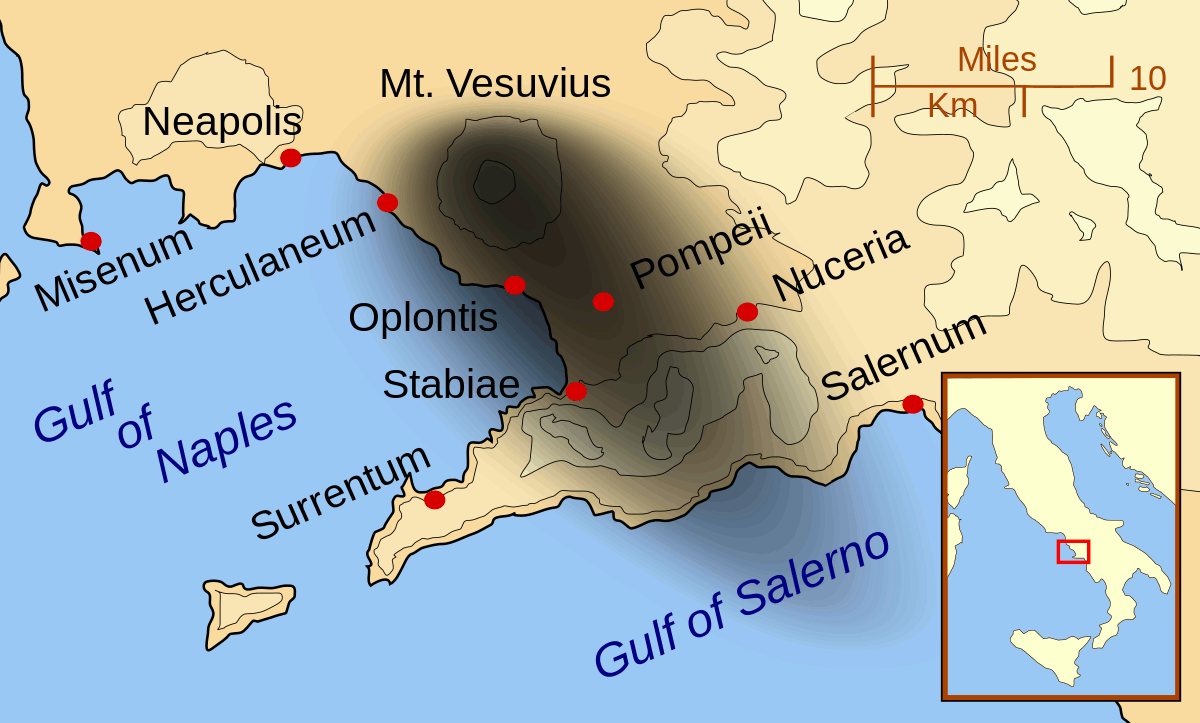
WORLD HERITAGE SITE
Naples' 2,800-year history has left it with a wealth of historical buildings and monuments, from medieval castles to classical ruins, and a wide range of culturally and historically significant sites nearby, including the Palace of Caserta and the Roman ruins of Pompeii and Herculaneum. In 2017 the
BBC defined Naples as "the Italian city with too much history to handle".
The most prominent forms of architecture visible in present-day Naples are the Medieval, Renaissance and Baroque styles. Naples has a total of 448 historical churches (1000 in total), making it one of the most
Catholic cities in the world in terms of the number of places of worship. In 1995, the historic centre of Naples was listed by UNESCO as a World Heritage Site, a United Nations programme which aims to catalogue and conserve sites of outstanding cultural or natural importance to the common heritage of mankind.
Naples is one of the most ancient cities in Europe, whose contemporary urban fabric preserves the elements of its long and eventful history. The rectangular grid layout of the ancient Greek foundation of Neapolis is still discernible. It has indeed continued to provide the layout for the present-day Historic Centre of Naples, one of the major Mediterranean port cities. From the Middle Ages to the 18th century, Naples was a focal point in terms of art and architecture, expressed in its ancient forts, the royal ensembles such as the Royal Palace of 1600, and the palaces and churches sponsored by the noble families.
— UNESCO's Criterion
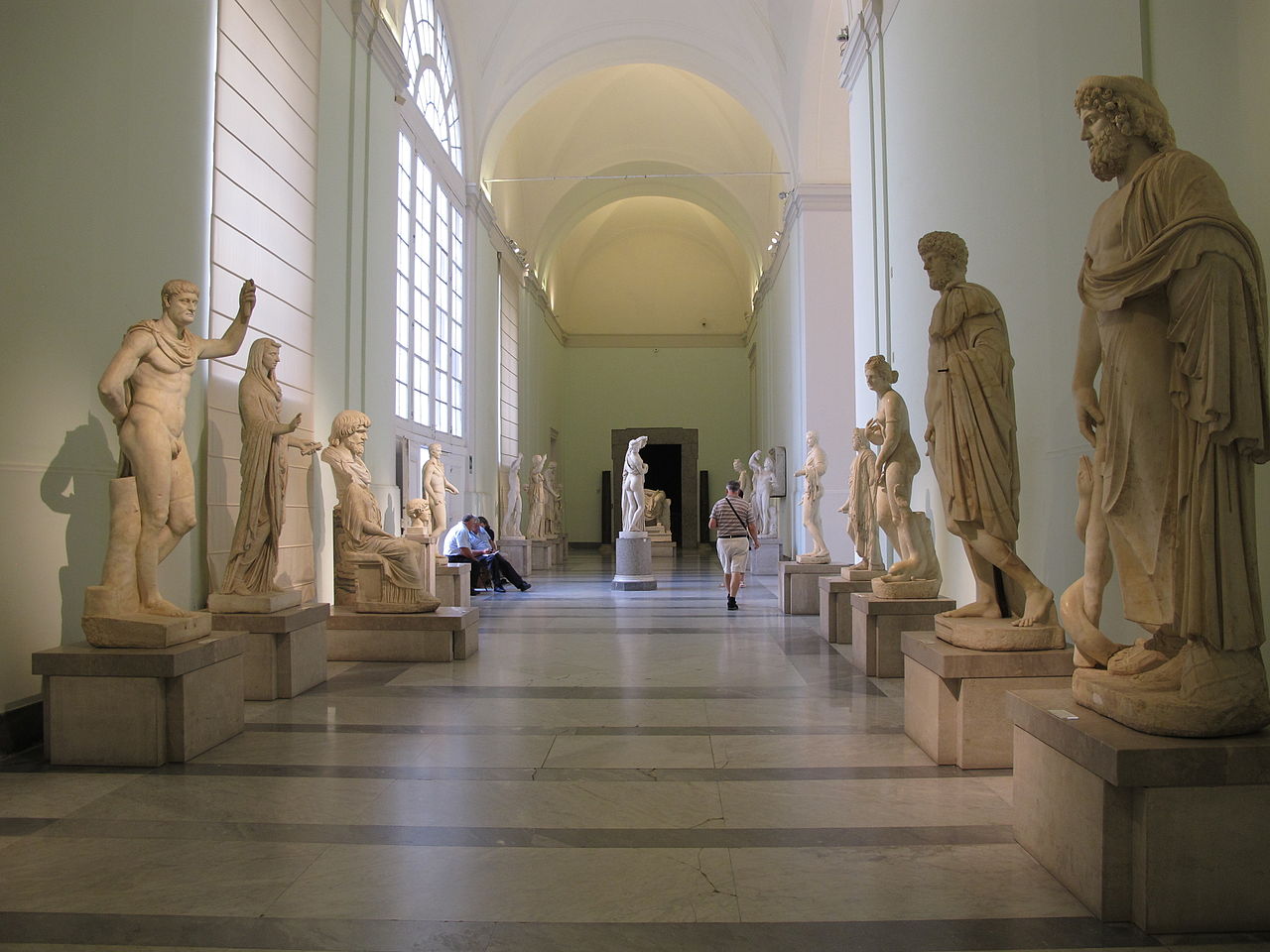
National Archaeology Museum, Naples, Italy
The city is situated on the Gulf of Naples, on the western coast of southern Italy; it rises from
sea level to an elevation of 450 metres (1,480 ft). The small rivers that formerly crossed the city's centre have since been covered by construction. It lies between two notable volcanic regions, Mount Vesuvius and the Campi Flegrei (Phlegraean Fields). Campi Flegrei is considered a supervolcano. The islands of Procida, Capri and Ischia can all be reached from Naples by hydrofoils and ferries. Sorrento and the Amalfi Coast are situated south of the city. At the same time, the Roman ruins of Pompeii, Herculaneum, Oplontis and Stabiae, which were destroyed in the eruption of Mount Vesuvius in 79 AD, are also visible nearby. The port towns of Pozzuoli and Baia, which were part of the Roman naval facility of Portus
Julius, lie to the west of the city.
Naples has a Mediterranean climate (Csa) in the Köppen climate classification. The climate and fertility of the Gulf of Naples made the region famous during Roman times, when emperors such as Claudius and Tiberius holidayed near the city. Maritime features mitigate the winters but occasionally cause heavy rainfall, particularly in the autumn and winter. Summers feature high temperatures and humidity.
Winters are mild, and snow is rare in the city area but frequent on Mount Vesuvius. November is the wettest month in Naples, while July is the driest.
ECONOMY
Naples, within its administrative limits, is Italy's fourth-largest economy after Milan, Rome and Turin, and is the world's 103rd-largest urban economy by purchasing power, with an estimated 2011 GDP of US$83.6 billion, equivalent to $28,749 per capita. Naples is a major cargo terminal, and the port of Naples is one of the
Mediterranean's largest and busiest. The city has experienced significant economic growth since
World War
II, but joblessness remains a major problem, and the city is characterised by high levels of political corruption and organised crime.
Naples is a major national, and international tourist destination, one of Italy's and Europe's top tourist cities. Tourists began visiting Naples in the 18th century during the Grand Tour.
In the last decades, there has been a move away from a traditional agriculture-based economy in the province of Naples to one based on service industries. The service sector employs the majority of Neapolitans, although more than half of these are small enterprises with fewer than 20 workers; about 70 companies are said to be medium-sized with more than 200 workers, and about 15 have more than 500 workers.
TOURISM
Naples is, with Florence, Rome, Venice and Milan, one of the main Italian tourist destinations. With 3,700,000 visitors in 2018, the city has completely emerged from the strong tourist depression of past decades (due primarily to the unilateral destination of an industrial city but also due to the damage to the city's image caused by the Italian media, from the 1980 Irpinia
earthquake and the waste crisis, in favour of the coastal centres of its metropolitan area). To adequately assess the phenomenon, however, it must be considered that a large slice of tourists visit Naples per year, staying in the numerous localities in its surroundings, connected to the city with both private and public direct lines. Daily visits to Naples are carried out by various Roman tour operators and by all the main tourist resorts of Campania: as of 2019, Naples is the tenth most visited municipality in Italy and the first in the South.
The sector is constantly growing and the prospect of reaching the art cities of its level is once again expected in a relatively short time; tourism is increasingly assuming a decisive weight for the city's economy, which is why, exactly as happened for example in the case of Venice or Florence, the risk of gentrification of the historic centre is now high.
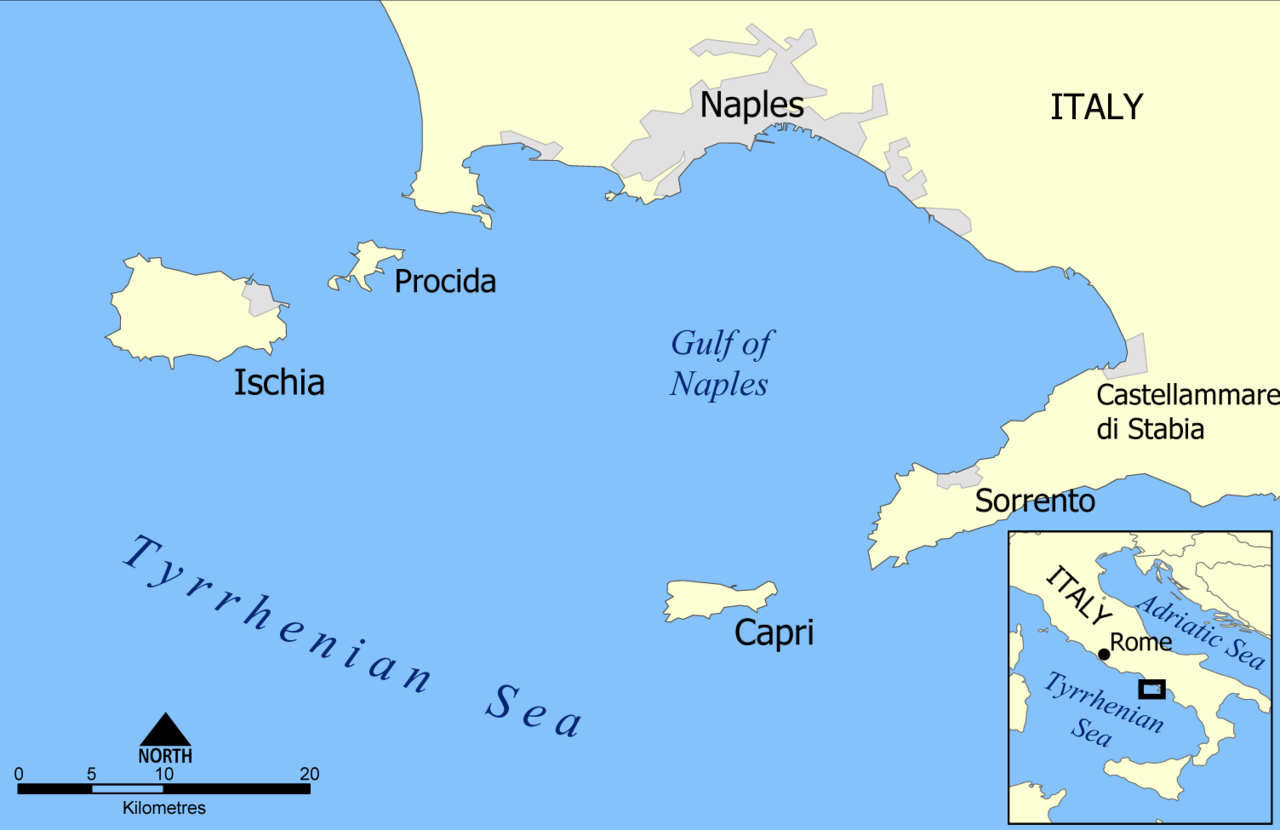
TRANSPORT
Naples is served by several major motorways (it: autostrade). The Autostrada A1, the longest motorway in Italy, links Naples to
Milan. The A3 runs southwards from Naples to Salerno, where the motorway to Reggio Calabria begins, while the A16 runs east to Canosa. The A16 is nicknamed the autostrada dei Due Mari ("Motorway of the Two
Seas") because it connects the
Tyrrhenian Sea to the
Adriatic
Sea.
Suburban rail services are provided by Trenitalia, Circumvesuviana, Ferrovia Cumana and Metronapoli.
The city's main railway station is Napoli Centrale, which is located in Piazza Garibaldi; other significant stations include the Napoli Campi Flegrei and Napoli Mergellina. Napoli Afragola serves high-speed trains that do not start or finish at Napoli Centrale railway station. Naples' streets are famously narrow (it was the first city in the world to set up a pedestrian one-way street), so the general public commonly use compact hatchback cars and scooters for personal transit. Since 2007 trains running at 300 km/h (186 mph) have connected Naples with Rome with a journey time of under an hour, and direct high speed services also operate to Florence, Bologna, Milan, Turin and Salerno. Direct sleeper 'boat train' services operate nightly to cities in Sicily.
The port of Naples runs several ferry, hydrofoil, and
SWATH
catamaran lines to Capri, Ischia and Sorrento, Salerno, Positano and Amalfi.
Services are also available to Sicily, Sardinia, Ponza and the Aeolian Islands. The port serves over 6 million local passengers annually, plus a further 1 million international cruise ship passengers. A regional
hydrofoil transport service, the "Metropolitana del Mare", runs annually from July to September, maintained by a consortium of shipowners and local administrations.
The Naples International Airport is located in the suburb of San Pietro a Patierno. It is the largest airport in southern Italy, with around 250 national and international flights arriving or departing daily.
The average commute with public transit in Naples on a weekday is 77 minutes. Nineteen per cent of public transit commuters ride for more than 2 hours every day. The average time people wait at a stop or station for public transit is 27 minutes, while 56% of riders wait for over 20 minutes. The average distance people usually ride in a single trip with public transit is 7.1 km (4.4 mi), while 11% travel for over 12 km (7.5 mi) in a single direction.
MOUNT VESUVIUS
Of the many eruptions of Mount Vesuvius, a major stratovolcano in Southern Italy, the best-known is its eruption in 79 AD, which was one of the deadliest in history.
In autumn of 79 AD, Mount Vesuvius violently spewed forth a cloud of super-heated tephra and gases to a height of 33 km (21 mi), ejecting molten rock, pulverized pumice and hot ash at 1.5 million tons per second, ultimately releasing 100,000 times the thermal
energy of the atomic bombings of
Hiroshima and
Nagasaki. The event gives its name to the Vesuvian type of volcanic eruption, characterised by columns of hot gases and ash reaching the stratosphere, although the event also included pyroclastic flows associated with Pelean eruptions.
The event destroyed several Roman towns and settlements in the area. Pompeii and Herculaneum, obliterated and buried underneath massive pyroclastic surges and ashfall deposits, are the most famous examples. Archaeological excavations have revealed much of the towns and the lives of the inhabitants leading to the area becoming the Vesuvius National Park and a
UNESCO World Heritage Site.
The total population of both cities was over 20,000. The remains of over 1,500 people have been found at Pompeii and Herculaneum so far, although the total death toll from the eruption remains unknown.
POMPEII
Pompeii was an ancient city in what is now the comune (municipality) of Pompei, near Naples, in the Campania region of Italy. Along with Herculaneum, Stabiae, and many surrounding villas, the city was buried under 4 to 6 m (13 to 20 ft) of volcanic ash and pumice in the eruption of Mount Vesuvius in 79 AD.
Largely preserved under the ash, Pompeii offers a unique snapshot of Roman life, frozen at the moment it was buried, as well as insight into ancient urban planning. It was a wealthy town of 10,000 to 20,000 residents at the time it was destroyed. It hosted many fine public buildings and luxurious private houses with lavish decorations, furnishings and artworks, which were the main attractions for early excavators; subsequent excavations have found hundreds of private homes and businesses reflecting various architectural styles and social classes, as well as numerous public buildings. Organic remains, including
wooden objects and
human bodies, were interred in the ash; their eventual decay allowed
archaeologists to create moulds of figures in their final moments of life. The numerous graffiti carved on outside walls and inside rooms provide a wealth of examples of the largely lost Vulgar Latin spoken colloquially at the time, contrasting with the formal language of classical writers.
Following its destruction, Pompeii remained largely undisturbed until its rediscovery in the late 16th century. Major excavations did not begin until the mid-18th century, which marked the emergence of modern archeology; initial efforts to unearth the city were haphazard or marred by looting, resulting in many items or sites being damaged or destroyed. By 1960, most of Pompeii had been uncovered but left in decay; further major excavations were banned or limited to targeted, prioritised areas. Since 2018, these efforts have led to new discoveries in some previously unexplored areas of the city, including a banquet hall adorned with rare, well preserved frescoes depicting various mythological scenes and figures.
Pompeii is a UNESCO World Heritage Site, owing to its status as "the only archaeological site in the world that provides a complete picture of an ancient Roman city." It is among the most popular tourist attractions in Italy, with approximately 2.5 million visitors annually.
Pompeii was built approximately 40 m (130 ft) above sea level on a coastal lava plateau created by earlier eruptions of Mount Vesuvius (8 km or 5 mi distant). The plateau fell steeply to the south and partly to the west into the sea. Three layers of sediment from large landslides lie on top of the lava, perhaps triggered by extended rainfall. The city, once by the shoreline, is today circa 700 m (2,300 ft) inland. The mouth of the navigable Sarno River, adjacent to the city, was protected by lagoons and served early Greek and Phoenician sailors as a haven port, later developed by the Romans.
Pompeii covered a total of 64 to 67 hectares (160 to 170 acres) and was home to 11,000 to 11,500 people, based on household counts.
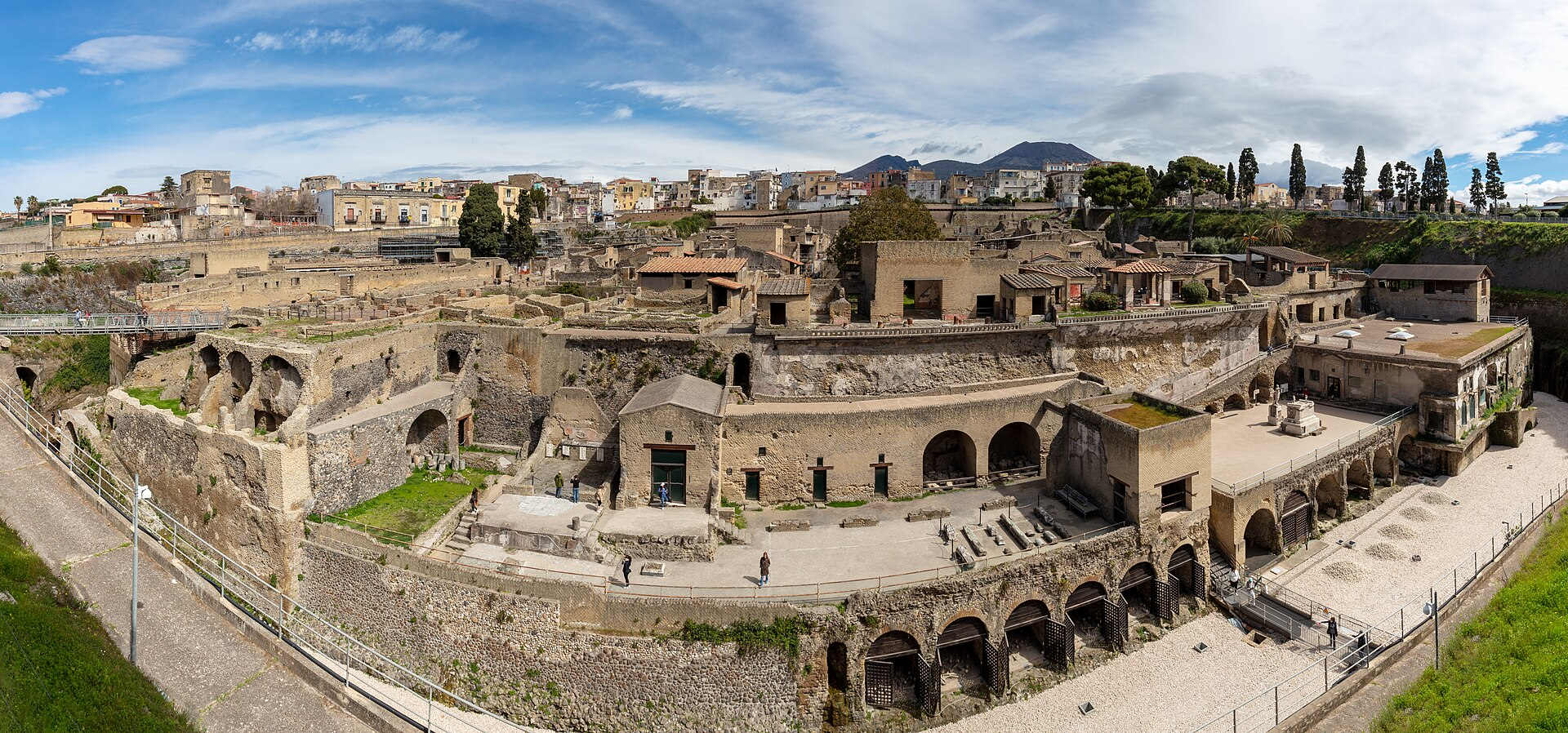
The Italian
town of Herculaneum was covered in ash when Vesuvius erupted in 79 AD
HERCULANEUM MOUNT VESUVIUS ERUPTION 79 AD
Herculaneum was an ancient Roman town, located in the modern-day comune of
Ercolano, Campania, Italy. Herculaneum was buried under volcanic ash and pumice in the Eruption of Mount Vesuvius in 79 AD.
Like the nearby city of Pompeii, Herculaneum is famous as one of the few ancient cities to be preserved nearly intact, as the ash that blanketed the town protected it against looting and the elements. Although less known than Pompeii today, it was the first and, for a long time, the only discovered Vesuvian city (in 1709). Pompeii was revealed in 1748 and identified in 1763. Unlike Pompeii, the mainly pyroclastic material that covered Herculaneum carbonized and preserved more wooden objects such as roofs, beds, and doors, as well as other organic-based materials such as food and papyrus.
According to the traditional tale, the city was rediscovered by chance in 1709, during the drilling of a well. Remnants of the city, however, were already found during earlier earthworks. In the years following the site's uncovering, treasure seekers excavated tunnels and took artifacts. Regular excavations commenced in 1738 and have continued irregularly since. Today, only a fraction of the ancient site has been excavated. The focus has shifted to preserving the already-excavated portions of the city rather than exposing more.
Although smaller than Pompeii with a population of circa 5,000, Herculaneum was a wealthier town. It was a seaside retreat for the Roman elite, as reflected by the extraordinary density of luxurious houses featuring lavish use of coloured marble cladding. Buildings of the ancient city include the Villa of the Papyri and the so-called "boat houses", where the skeletal remains of at least 300 people were found.
The eruption of Mount Vesuvius in AD 79 buried Herculaneum under approximately 20 m (66 ft) of ash. It lay hidden and largely intact until discoveries from wells and tunnels became gradually more widely known, notably following the Prince d'Elbeuf's explorations in the early 18th century. Excavations continued sporadically up to the present and today many streets and buildings are visible, although over 75% of the town remains buried. Today, the Italian towns of Ercolano and Portici lie above Herculaneum. Ercolano was called Resina until 1969 when the modern name was adopted in honour of the old city.
The course and timeline of the eruption can be reconstructed based on archaeological excavations and two letters from Pliny the Younger to the Roman historian
Tacitus.
At around 1 pm on the first day of eruption, Mount Vesuvius began spewing volcanic material thousands of metres into the sky. After the plume had reached a height of 27–33 km (17–21 mi), the top of the column flattened, prompting Pliny to describe it to Tacitus as a stone pine tree. The prevailing winds at the time blew toward the southeast, causing the volcanic material to fall primarily on the city of Pompeii and the surrounding area. Since Herculaneum lay west of Vesuvius, it was only mildly affected by the first phase of the eruption. While roofs in Pompeii collapsed under the weight of falling debris, only a few centimetres of ash fell on Herculaneum, causing little damage; nevertheless, the ash prompted most inhabitants to flee.
The volcano continued spewing up a high-altitude column from which ash and pumice began to fall, blanketing the area. At 1 am the next day the eruptive column collapsed onto Vesuvius and its flanks. The first pyroclastic surge, formed by a mixture of ash and hot gases, flowed down the mountain and through the mostly-evacuated town of Herculaneum at 160 km/h (100 mph). A succession of six flows and surges buried the city's buildings to approximately 20 m (66 ft) depth, causing little damage in some areas and preserving structures, objects and victims almost intact. However, other areas were damaged significantly, knocking down walls, tearing away columns and other large objects; a marble statue of Marcus Nonius Balbus near the baths was blown 15 m (49 ft) away and a carbonised skeleton was found lifted 2.5 m (8 ft 2 in) above ground level in the garden of the House of the Relief of
Telephus.
The date of the eruption has been shown to be on or after 17 October. Support for an October/November eruption has long been known in several respects: buried people in the ash were wearing heavier clothing than the light summer clothes typical of August; fresh fruit and vegetables in the shops are typical of October – and conversely the summer fruit typical of August was already being sold in dried, or conserved form. Wine fermenting jars had been sealed, which would have happened around the end of October; coins found in the purse of a woman buried in the ash include one with a 15th imperatorial acclamation among the emperor's titles and could not have been minted before the second week of September.
Multidisciplinary research on the lethal effects of the pyroclastic surges in the Vesuvius area has shown that, in the vicinity of Pompeii and Herculaneum, intense heat was the main cause of the death of people who had previously been thought to have died by ash suffocation. Exposure to ≥250 °C (480 °F) had likely killed residents within 10 km, including those sheltering in buildings.
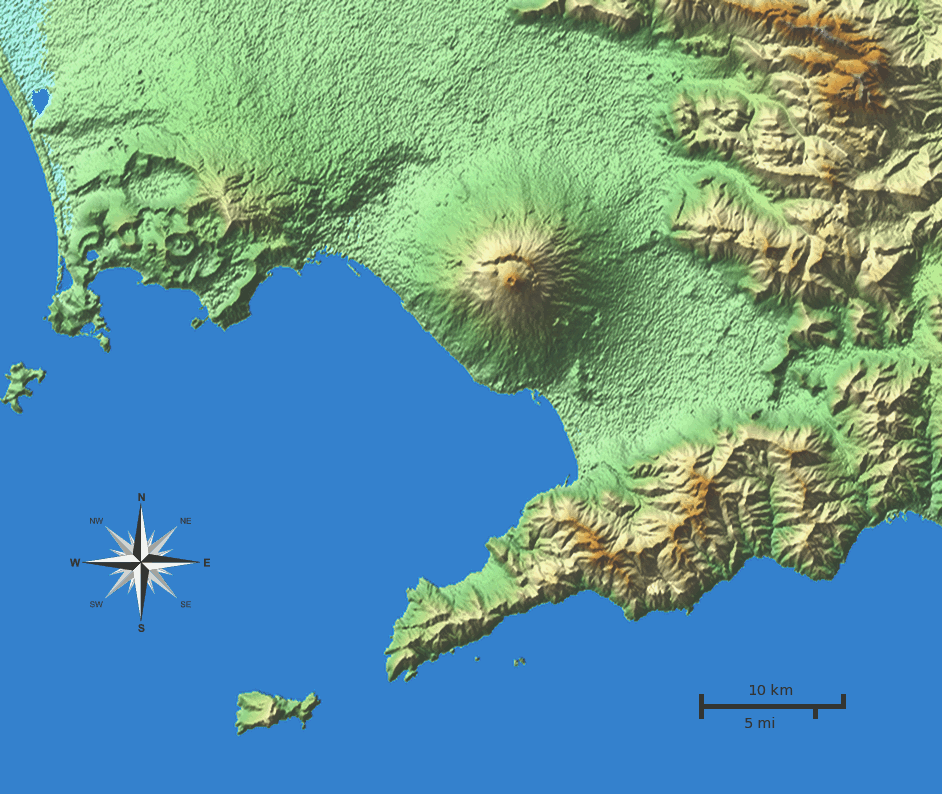
Mount
Vesuvius is clearly visible on this topographical map of the Gulf of
Naples
GULF OF NAPLES
The Gulf of Naples (Italian: Golfo di Napoli), also called the Bay of Naples, is a roughly 15-kilometer-wide (9.3 mi) gulf located along the south-western coast of Italy (province of Naples, Campania region). It opens to the west into the Mediterranean Sea. It is bordered on the north by the cities of Naples and
Pozzuoli, on the east by Mount Vesuvius, and on the south by the Sorrento Peninsula and the main town of the peninsula, Sorrento. The Peninsula separates the Gulf of Naples from the Gulf of Salerno, which includes the Amalfi Coast.
The islands of Capri, Ischia and Procida are located in the Gulf of Naples. The area is a tourist destination, with the seaside Roman ruins of Pompeii and Herculaneum at the foot of Mount Vesuvius (destroyed in the AD 79 eruption of Vesuvius), along the north coast.
Along with the island of Ischia and gulfs of Pozzuoli and Gaeta, local waters are home to varieties of whales and dolphins including fin and sperm whales.
It is said that the Roman emperor Caligula built a bridge of boats across the bay and rode across it in a chariot while wearing the armor of Alexander the Great.
The Gulf of Naples hosted the sailing events for the 1960 Summer Olympics in Rome.

The Temple of Apollo, at Pompeii near Mount Vesuvius, Naples, Italy
WORLD
WAR THREE
In
the event of an international nuclear holocaust, World
War Three will wipe out much of Naples.
CHAPTERS
| CHARACTERS
| MEDIA
|
MOVIE REF |
SCREENPLAYS
|






